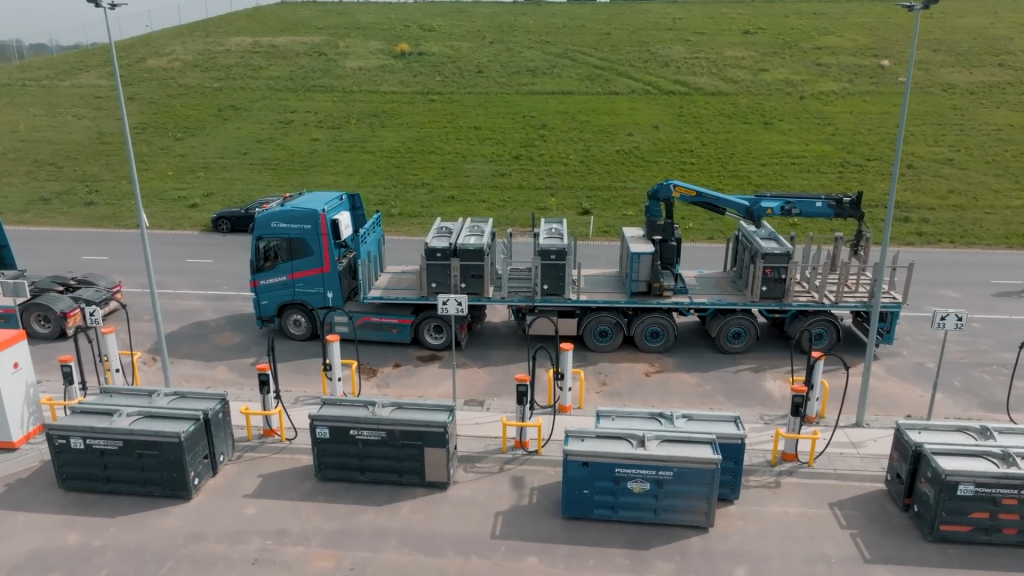There’s something profoundly futuristic about silence, especially on a construction site.
Gone are the diesel engines, the constant rumble of idling machines, and the exhaust haze. In their place are clean air, calm surroundings, and the quiet hum of innovation at work.
This is not a vision of the distant future. It’s happening right now in the Netherlands, where an ambitious flood protection project is setting a global precedent. It is the first known fully electric heavy construction site in operation.
We first discovered this inspiring project through a video by construction YouTuber Aaron Witt (BuildWitt). It is a must-watch if you’re interested in the future of construction.
The impact goes far beyond engineering. It signals that the construction and infrastructure industries are poised for transformation, powered not by fuel but by foresight.
Engineering Meets Electrification
Located inland from Amsterdam along a 20-kilometre stretch of the Ball River, this project is part of the Dutch government’s National Flood Program. In response to increasing flood risks, the dykes here are being raised, widened, and reinforced to protect nearby communities.
What sets this project apart is not its size or purpose. It is being built entirely with electric equipment. Every excavator, tractor, and crane is powered by electricity, and much of that energy is generated renewably on site.
This results from a bold collaboration between the contractor, equipment suppliers, and government agencies focused on sustainability. It proves that even large-scale construction can go clean, quiet, and low-emission.
Electric Equipment in Action

At the core of this operation are capable and custom-engineered machines for electrified performance.
The Caterpillar 330 Z-Line is one of the world’s first fully electric 30-ton excavators, leading the charge. Designed with extended booms, widened undercarriages for added stability, and 3D GPS for precision slope work, this machine doesn’t compromise on power.
Tractors on-site are equally impressive. Outfitted with front-mounted battery packs, they operate for hours and are part of a seamless battery-swapping system. Depleted units are removed and replaced on the fly with charged ones from a central hub, ensuring machines stay productive without delays.
Even the cranes are electric. These machines are powered by trailing cable connections to external battery packs, which can be recharged or replaced independently of the crane.
Revolutionizing Construction Charging Systems
Operating over 40 electric machines daily demands an innovative and scalable charging infrastructure.
At the heart of the system are mobile mega-batteries. These containerized units, each holding between 385 and 800 kilowatt-hours, are recharged using a combination of solar panels and wind turbines close to the site. This creates a self-sufficient power loop. Once charged, the batteries are loaded onto trailers and delivered to machines throughout the site.

Excavators plug into these mobile charging stations during scheduled morning and lunch breaks. Thanks to 350-kilowatt fast charging, the machines receive enough energy in two hours to complete their shifts. Overnight, they return to base for a full recharge.
Tractors follow a different model. Rather than recharge in place, they swap out their front-mounted battery packs at a central station. This process takes only a few minutes and keeps them in continuous operation.
The cranes are powered by stationary battery units that connect via high-capacity cables. This setup allows for reliable, uninterrupted operation and simplifies maintenance.
All the charging units are designed to accept AC input, with onboard conversion to DC, which allows compatibility with different grid conditions and enables deployment in remote or off-grid areas. The system can charge multiple machines in parallel and includes built-in cooling for safety and performance.
Performance Without Pollution
This fully electric strategy has led to a 94 percent reduction in nitrogen oxide emissions. That is a huge improvement for a project located near family homes and environmentally sensitive areas.
Beyond emissions reduction, this project redefines what’s possible in heavy construction. It shows that electric equipment can match or even exceed the performance of traditional diesel machines, while also improving air quality, reducing noise, and supporting long-term sustainability goals.
See It for Yourself
This worksite may be quiet, but its message is powerful. The future is electric, and it is already here.
Want to see it in action? We highly recommend watching Aaron Witt’s full video here.
Inspired? Let’s talk about how Signature Electric can help bring a future-forward vision to your next project.


